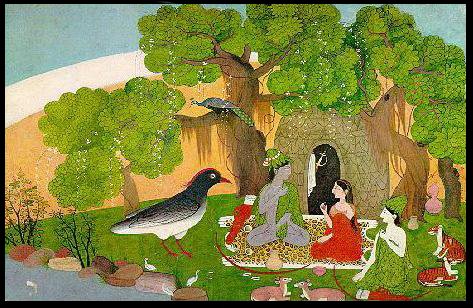Pahari School, Chamba kalam, Kangra idiom
Circa A.D. 1780-1785 Size: 33.3 x 22.8 cm
As Rama was proceeding to Panchavati he observed a mighty eagle. Seeing that bird in the woods, the two princes thought it to be a demon and inquired who he was. The bird, in gentle tones answered, "Dear child, I am a friend of your father." In deference to this relationship, Rama paid obeisance to him and inquired of him about his name and lineage. The bird at length gave the account of the birth of devas, daityas, men, animals, and even trees, and said that Vinata gave birth to two sons, Garuda and Aruna, and he himself and his brother Sampati were the sons of Aruna. The bird then gave his name as Jatayu and offered to keep watch over Sita whenever the two brothers might be away.
After reaching the beautiful Panchavati they selected a site, full of trees, near a water pool. The river Godavari is seen flowing smoothly in the left foreground of the composition. Lakshmana built a spacious hut of graceful bamboos and mud, thatched with boughs of the sami trees, where we see Rama with Sita and Lakshmana settled in peace. Rama is gazing affectionately at Sita while they are seated on a leopard skin conversing with each other. Lakshmana and the great eagle Jatayu are shown on each side of them as if in attendance on the divine couple. Jatayu in these paintings does not have the appearance of an eagle but of some mighty bird.
A pair of deer seated in the foreground, the birds, and a peacock perched on a tree, are all rendered in a naturalistic manner, but the tiger cubs at the right lower corner are less realistic. The artist doubtless had never seen a tiger and painted this animal only from descriptions of this beast. The naturalistic foreground is in contrast to the background shown in three almost parallel curved bands of ochre-yellow, white, and light blue. These bold bands are partly concealed by trees of strangely twisted yet alluring shapes, and thus do not dominate the scene. The trees appear to be the banyan, which is considered to increase the merit of tapas (penance). Creepers with flowers, predominantly white, enhance the beauty of the hermitage. |
